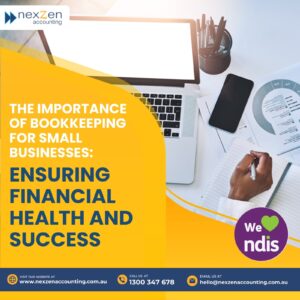Meeting your tax obligations each year is important. One area of taxation that often confuses support providers is what does—and does not—count as an eligible tax deduction?
But first—what’s a tax deduction?
Tax deductions are claims for expenses directly tied to the business that business owners can list on their return.Tax deductions reduce your amount of taxable income, boosting your refund at the end of the year.A tax deduction can include any work-related expense, such as the cost of uniforms, tools used in your practice, and any work-related travel.
Are there rules for claiming tax deductions?
Let’s start with the basics. To claim any deduction on your return, you must adhere to the Australian Taxation Office’s (ATO) three rules:
- The claim must be for an expense directly tied to your business, not for a private expense.
- For expense claims that are both business and private, you may only claim the business portion.
- You must have a record of the expense.
Support providers often miss out on deductions—or claim items that don’t meet the above parameters—simply because they don’t understand which deductions are allowed.
12 Common Deductions for Support Providers
NexZen Accounting has created this list of the 12 most common deductions for support providers (based on this list from the ATO) to help you with your tax preparation this year:
- Vehicle expense
- Home-based business expense
- Travel expense for business
- Worker salary, wage, and super contribution expense
- Repair, maintenance, and replacement expense
- Working expense
- Asset depreciation and capital expense
- Consumables expenses
- Work-from-home expenses
- Mobile and internet expenses
- Computer, laptop, and office equipment expenses
- Tax accounting professional services
Let’s take a closer look at these allowable expenses.
Vehicle expenses
If you must drive your car for work, you can claim a deduction.You cannot claim the vehicle expense deduction for your necessary trips from home to work and back.
- Home-based business expense
- If you carry out some or all business activities from home, you might be allowed to claim:
- Occupancy expense, such as mortgage, rent, land tax, and council rates
- Running expense, such as phone, electricity, furniture, furniture repairs, and cleaning
- Motor vehicle trips from your home to other places as long as the trip is business-related
- Work-related travel
In addition to your vehicle expenses, you may also have work-related travel expenses. These can include toll charges, airfare, bus passes, or meals when you’re traveling for work and staying overnight.You can claim travel from the home of one client to another, and sometimes you can also claim travel for work-related activities with a client, such as appointments.You may also be able to claim meals that you have with clients when traveling.
Worker salary, wage, and super contribution expense
Because you own a business, you can typically claim deductions for:
- Employee salary and wage compensation
- Super contributions into a compliant super fund or RSA for employees and some contractors.
These are also typical operating expenses.If you run your business as a sole trader, you can also claim your own contributions on your personal return.
Repair, maintenance, and replacement expense
Deductions for repair, maintenance, or replacement expenses are allowed as long as: The amount was used to replace machinery, tools, or a physical premises used to produce your business income. Claims cannot be for amounts considered capital expenses.
Working expense
These are expenses that occur in the everyday operation of your business. Such expenses could include:
- Company stationery
- Building rent
- Stock purchases
These are also sometimes referred to as operating expenses.Most operating expenses must be claimed in the income year in which you incurred them, and only the business-related portion can be claimed. For operating expenses that are both business and private, such as mobile calls, you can only deduct the business portion.
Asset depreciation and capital expenses
Capital expense deductions are generally claimed over time. You might be allowed to use an instant write-off, which lets you claim a deduction for the entire purchase cost in the financial year you bought the asset and used it. Capital expenses are either:
- Depreciating assets, including the purchase amount and the amount you incurred from its transport or installation
- The cost of improving your business
You must keep complete and accurate records of all expense deductions you wish to claim. Other allowable expenses include:
Consumable supplies
As a support provider, you probably pay for supplies that help you in your day-to-day job. Such supplies, or consumables, can include stationery, hand sanitiser, sunscreen, or printing paper.
Work-from-home expenses
It’s typical for support providers to perform some of their tasks from home. This can include such tasks as submitting timesheets, client activity research, phone calls, and emails.You can claim deductions for the time you spend working at home for such expenses as electric, air conditioning, or heating.If you also have a dedicated office space within your home, such as a spare room you use as an office only, you can enjoy an increased deduction. Beginning with the 2019-2020 financial year, you can claim a home office deduction even if you don’t have a dedicated office space. To claim the deduction, estimate how many hours you worked from your home office and multiply by the relevant rate for the year.
Mobile and internet expenses
Support providers typically use a mobile phone during the workday for work-related purposes. You probably also have a computer at home that’s connected to the internet. You probably use these devices to connect with clients or to organize your calendar. Any work-related usage of these devices is eligible for a deduction. If you also use these devices for non-work-related activities, you can only deduct the business-related portion.
Computer, laptop, and office equipment
Besides deducting your mobile and internet expenses, you might also be allowed to claim the purchase price of the phone or computer. If you work as a sole trader, you can deduct the entire purchase price of any mobiles or computers purchased during a financial year.
Tax accounting professional services
Some support providers use professional tax accountants like nexZen to prepare and send in their tax returns to the ATO. You can claim any amounts you pay to your tax accounting service in the tax year in which you paid it.
What expenses can you not claim as a deduction?
Some expenses generated during the course of business are not considered business-related. Some of the expenses that you cannot claim include:
- Entertainment
- Traffic fines
- Private expenses, such as childcare or family clothing
- Earned income expenses that aren’t assessable, such as hobby income
- GST on purchases that can be claimed as GST credits on your activity statement
Also, if you earn personal services income, there may be limits on deductions. nexZen Accounting Firm helps support providers around Australia with all their accounting needs—and we can help you, too. Reach out to the team today.










